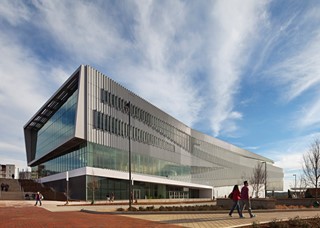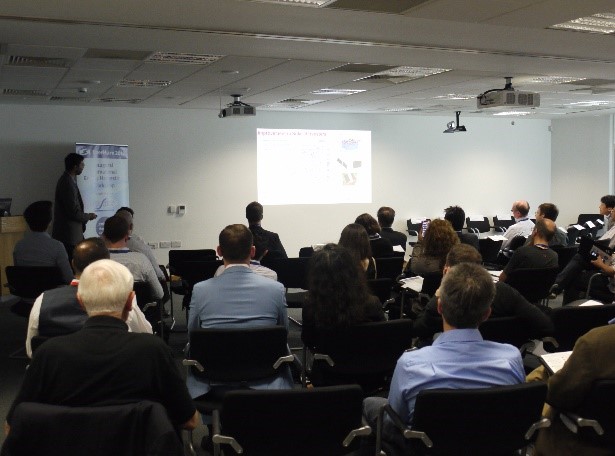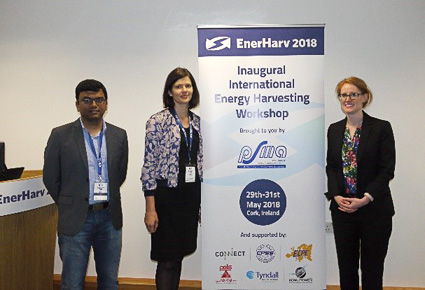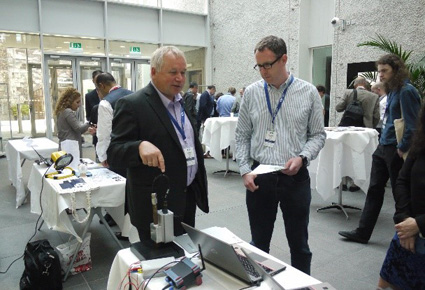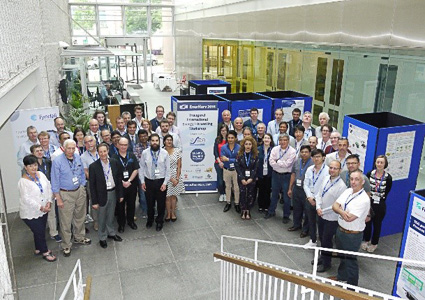April 5-7, 2022
ASSIST Center, North Carolina State University
"Building the Ecosystem for Powering the Internet of Things"
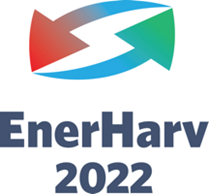
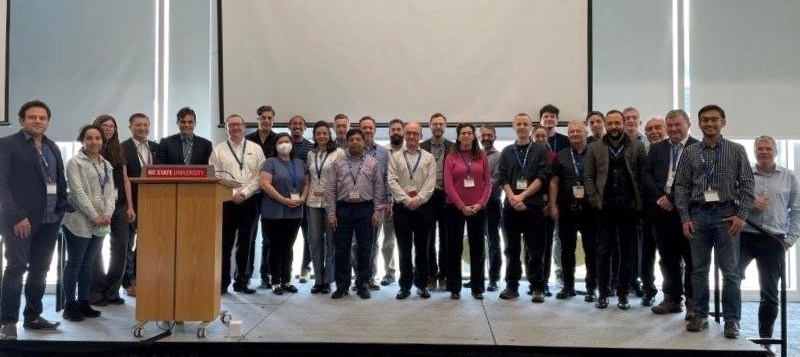
After a two-year, COVID-related deferral EnerHarv 2022 finally went ahead at the ASSIST Center in NCSU (North Carolina State University) USA from April 5-7, 2022. The event was organized by PSMA with EnABLES, ASSIST, IEEE PELS & CPSS as Technical Sponsors. This is becoming the 'must attend' biennial event for the 'power IoT' community including researchers, industry, developers, integrators and end users. Each day the Workshop offered a mix of technical sessions, demos, posters, panel sessions and of course lots of networking. Despite the uncertainties related to COVID-19, the Workshop attracted good attendance with more than 55 people.
EnerHarv 2022 opened each day with keynotes.
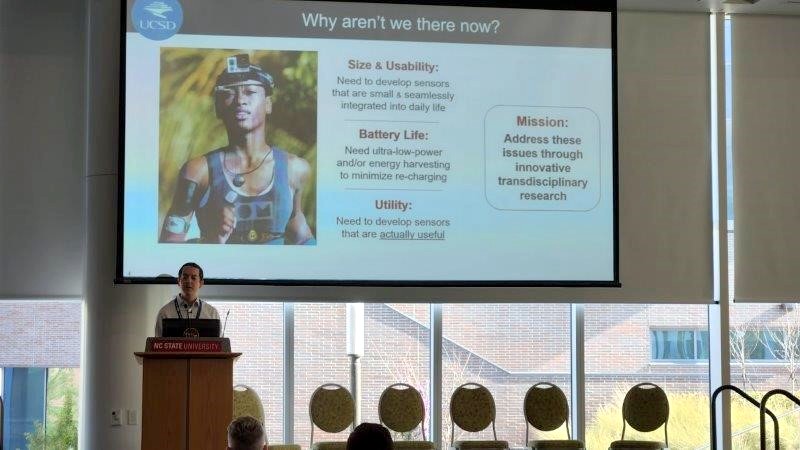
- On Day 1, Patrick Mercier, University of California San Diego, gave an insight into the emergence of 'unawareables,' the development and integration of miniaturized energy harvesting, wireless power transfer and related components and the advantages of integration at semiconductor and module levels. Coupled with various novel circuits, architectures and methods of moving and stacking inductors and capacitors, various innovative methods for integration/partitioning of components, circuits and systems were illustrated to minimize size, maximize wearability and
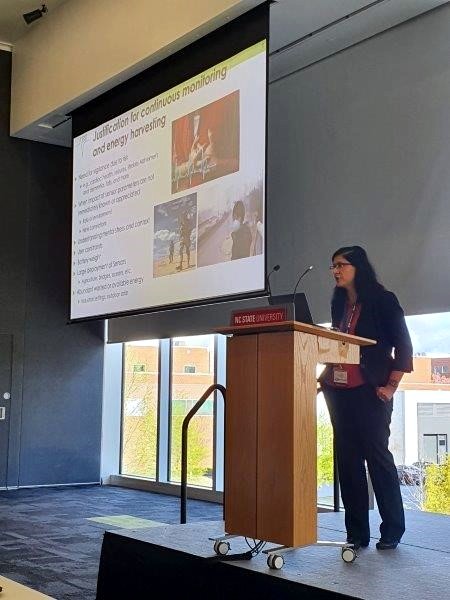 usability. The door is wide open to developers of better passives to migrate and integrate their technologies.
usability. The door is wide open to developers of better passives to migrate and integrate their technologies.
- On Day 2, Veena Misra, ASSIST Center, provided an overview of the activities of the ASSIST Center at NCSU, most notably the development of technologies and demonstrators for wearables. System integration and human interaction considerations are critical. For example, overcoming user forgetfulness can be lifesaving; flexibility and compatibility with working environments are essential. There are a multitude of fluids, enzymes, etc. that can be used for harvesting, storage or sensing. ASSIST has a rapid prototyping group to help create testbeds to drive technologies to higher TRLs (technology readiness levels).
- On Day 3, Baoxing Chen, Analog Devices, described how IoT is riding the third wave of the IT Revolution and gave a 'powering the IoT perspective' in terms of challenges and opportunities, especially
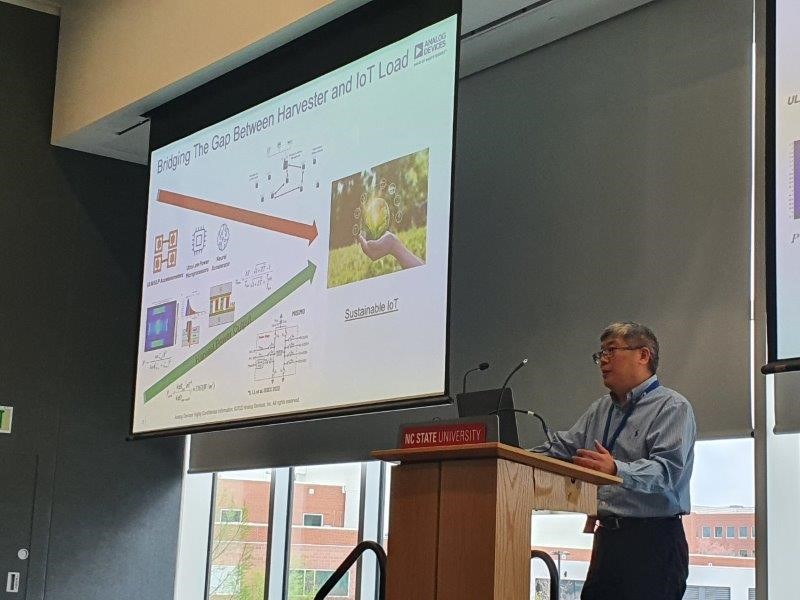 bridging the gap between harvester capabilities and load demand. This included some examples of ADI roadmap activities incorporating disruptive technologies particularly in the wearables and Industry 4.0 sectors for sensors, power management and wireless comms. For example, micro-TEG devices at chip scale will be able to give microWatt performance even at very small temperature gradients. Low-leakage, high-cycle supercaps are also in development. Additionally, ADI is looking at sustainability aspects – how to make parts reliable in terms of performance and lifetime.
bridging the gap between harvester capabilities and load demand. This included some examples of ADI roadmap activities incorporating disruptive technologies particularly in the wearables and Industry 4.0 sectors for sensors, power management and wireless comms. For example, micro-TEG devices at chip scale will be able to give microWatt performance even at very small temperature gradients. Low-leakage, high-cycle supercaps are also in development. Additionally, ADI is looking at sustainability aspects – how to make parts reliable in terms of performance and lifetime.
In the Transducer Session we learned from speakers from Tyndall National Institute, Research Institutes of Sweden (RISE) & Université de Sherbrooke the 'wideband' challenge for vibrational devices and various innovations at MEMS and mezo level with various ways of fabricating parts, integrating magnetics, piezo materials, etc. to address this. Noncritical low data rate condition monitoring of machinery (Industry 4.0, automotive, wind turbines, etc.) popped up in several sessions as an ideal application area for vibrational harvesters.
The System Integration Sessions on Days 1 and 2 gave great insight from both industry and academia into opportunities and challenges. A very nice methodology to assess storage technologies and their trade-offs, e.g. the use of spider charts was presented by CEA-Leti that could be also adapted for other technologies. A key common need is for easy tuning and multimodal capability for vibrational devices along with other challenges highlighted by the University of Limerick. For wireless power transfer (WPT), neuro-stimulation and telemetry for implantables are two promising areas. Pros and cons of ultrasonic over RF (size, delivery range, power density) were outlined by NCSU. FDA limits must be understood, and appropriate wireless comms protocols selected. Several examples of demonstrators were presented based on LoRaWAN & BLE platforms. Mid Sweden University (MIUN) gave a nice example of the suitability of vibrational harvesting technology for conditional monitoring of rotating machinery with improved sample rate possibilities at higher rotational speeds. In discussion forums, RISE highlighted the need to connect transducers (particularly vibrational) in a manner to give consistent performance. This is key for successful TRL progression and system integration, and we need more industrial and mechanical design people in our ecosystem, particularly at the module level. Several innovative WPT techniques were outlined by the University of Florida. For wearables and implantables we need to watch for biocompatibility, MRI compatibility, wear, stress, corrosion & user safety.
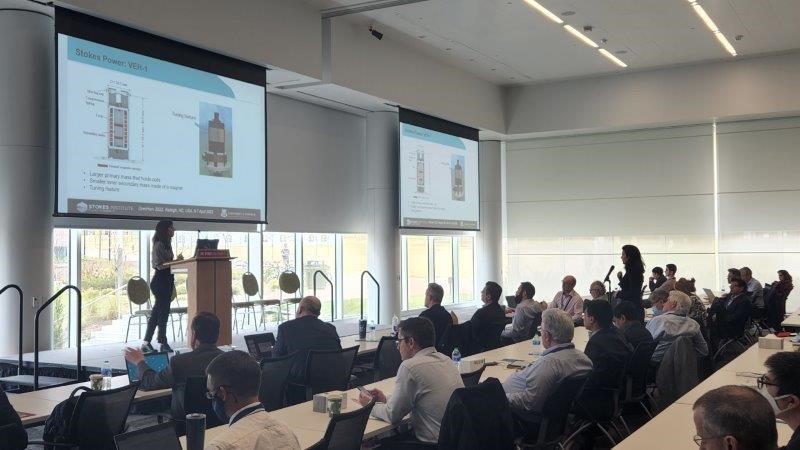
The Energy Storage Session comprised speakers from NAWA Technologies, Penn State University and NCSU. Energy storage was also prominently covered in the System Integration Sessions. A common theme was the use of nanotechnology at various scales from WSN-edge-device micro-batteries to higher-powered ultracaps for data centers and EVs. For example, NAWA uses vertically aligned nanotubes in their ultracaps, which when combined with conventional storage devices can mitigate voltage drops to give longer battery life. Features and trade-offs of different battery chemistries were outlined.
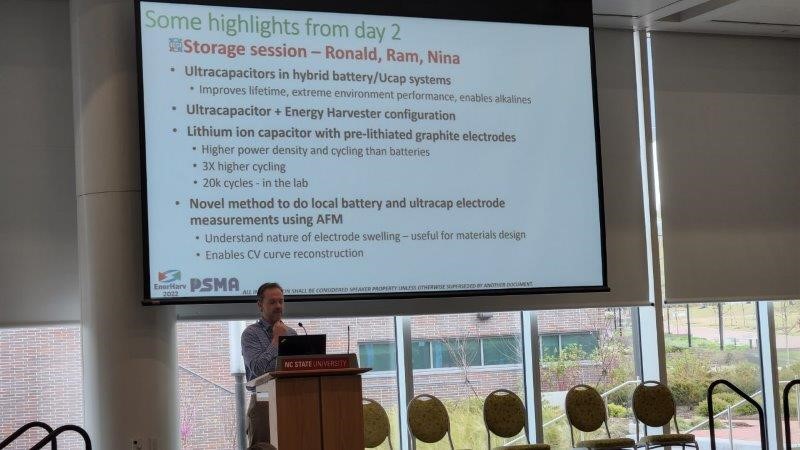 The Power Management Session comprised speakers from ST Microelectronics, Tyndall and ADI (formerly Maxim). Once again innovative power circuits and architectures were on display to assist with impedance matching (to maximize power transfer), cold start, voltage conditioning and digital interfacing to contextually minimize device power consumption. For example, the MISCHIEF circuit from Tyndall offers a modular circuit block approach offering low-risk, fast-time-to-market development and can harvest ambient energies currently unusable in the sub-10 mW area, particularly at low voltages. Several circuits are in development for WPT applications.
The Power Management Session comprised speakers from ST Microelectronics, Tyndall and ADI (formerly Maxim). Once again innovative power circuits and architectures were on display to assist with impedance matching (to maximize power transfer), cold start, voltage conditioning and digital interfacing to contextually minimize device power consumption. For example, the MISCHIEF circuit from Tyndall offers a modular circuit block approach offering low-risk, fast-time-to-market development and can harvest ambient energies currently unusable in the sub-10 mW area, particularly at low voltages. Several circuits are in development for WPT applications.
Two Panel Sessions were held:
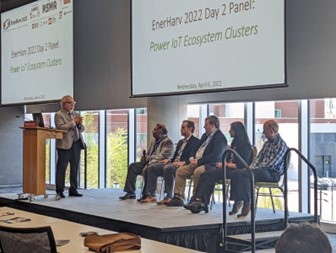
- The "Powering the Next-generation WSN Experience" Session on Day 1 had presenters representing a variety of backgrounds representing industry and academia (Wurth, STMicro, Tyndall, Sherbrooke). They had a fruitful discussion on the challenges, gaps, and opportunities associated with bringing the ubiquitous sensor and IoT/IIoT deployments of the near term to mainstream applications. Those closer to the field in industry highlighted the challenges associated with measuring very-low currents and matching the tech not to the "killer app" but rather to the "killer customer" to help catapult visibility. Those closer to the academic side highlighted the sustainability opportunities, the shifting landscapes of business models (i.e. – "data is the new oil") and need to collaborate with other communities and ecosystems (also a fantastic segue into the Day 2 panel).
- The Power IoT Ecosystem Session on Day 2 had representatives from various groups (ASSIST, CONNECT, EnABLES) all contributing to creating synergies and fostering collaborations between stakeholders in difference ways. The 'ecosystem of stakeholder' image from the EnABLES position paper (enables-project.eu) (highly influenced by the PSMA Energy Harvesting Committee (EHC)) was prominently used throughout the event to encourage and inspire people to participate and also to identify opportunities to add more to our ever-growing community of experts and users. For example, mechanical designers, software engineers and developers of business models were seen as areas where the outputs can find a stronger route to adoption and commercialization. All panelists saw major value in cross-connecting activities to realize synergies, e.g. hosting related events in an adjacent way (time and place) and cross-promoting, e.g. sharing of simulation tools, databases.
In the Demo Session we saw quite a variety of functional demonstrations of energy-harvesting (and related) technologies. As something the PSMA EHC has felt very strongly from putting together numerous events over the years, these lectures and discussions are far more fruitful and impactful when complemented by REAL demos people can touch and see work before their eyes. Such demos covered the use of transducers, energy storage, PMICs (along with the development environments to immediately utilize), and sensor telemetry data from various WSN implementations. Supporting aspects of the ecosystem, such as battery characterization, were demonstrated along with some real-world (shipping and proof-of-concept) products and applications.
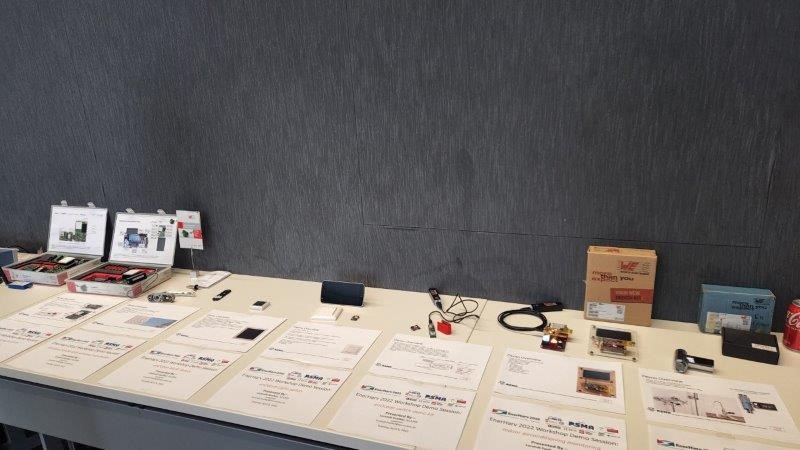
Ten Posters were on display from academic institutes, research centers and industry partners in Europe and US, primarily based on transducers, PMICs and energy storage solutions. Each poster presenter was given an opportunity to do an elevator pitch and it proved to be a great mechanism to stimulate dialogue and discussions between attendees on future potential collaborations. ASSIST & CONNECT already have leveraged funding mechanisms in place to stimulate collaborations, particularly wearables and Energy-Source-in-Package (eSIP) based WSN energy harvesting demonstrators. EnABLES is already funding many free of charge feasibility studies and subsequently leading to several project proposals and project starts. At future EnerHarvs, we anticipate successful outcomes from this with stronger links between poster and demo session content as we see our technologies progress in TRL level.
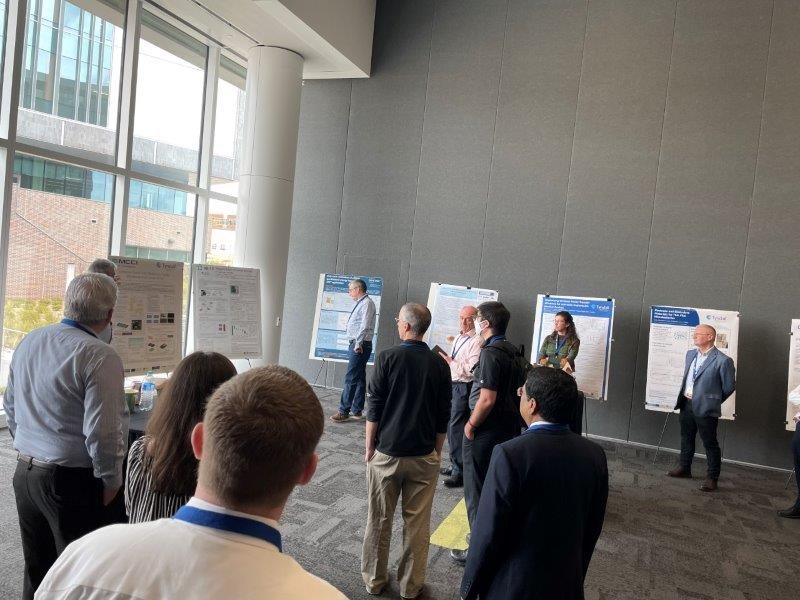
It was not all business as deep, technical discussions of the day turned into pleasurable, social and networking events in the evening. The first night was capped by a formal dinner at the Park Alumni Center located right on the NCSU campus. The team then piled onto a bus the second night for a social event at the Raleigh Beer Garden, which boasts the planet's largest selection of draft beers. Needless to say, much energy was harvested by all, as the pictures indicate.
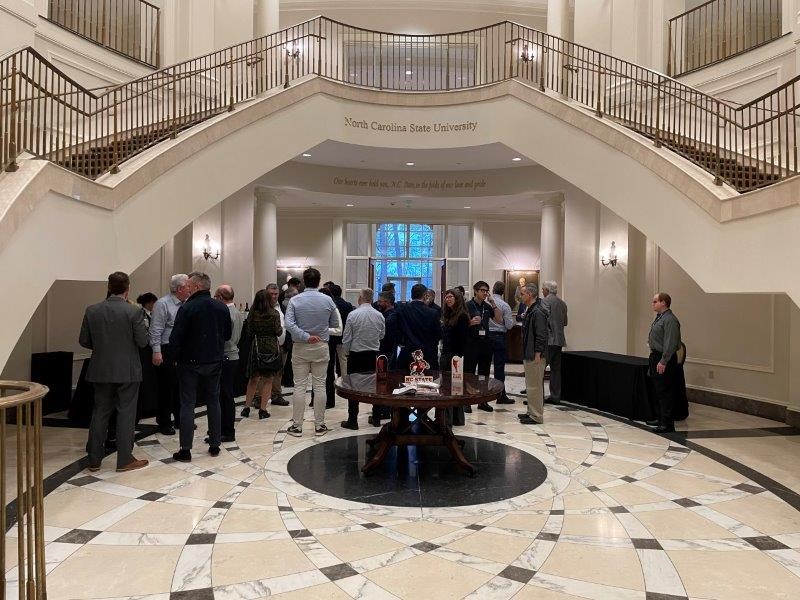
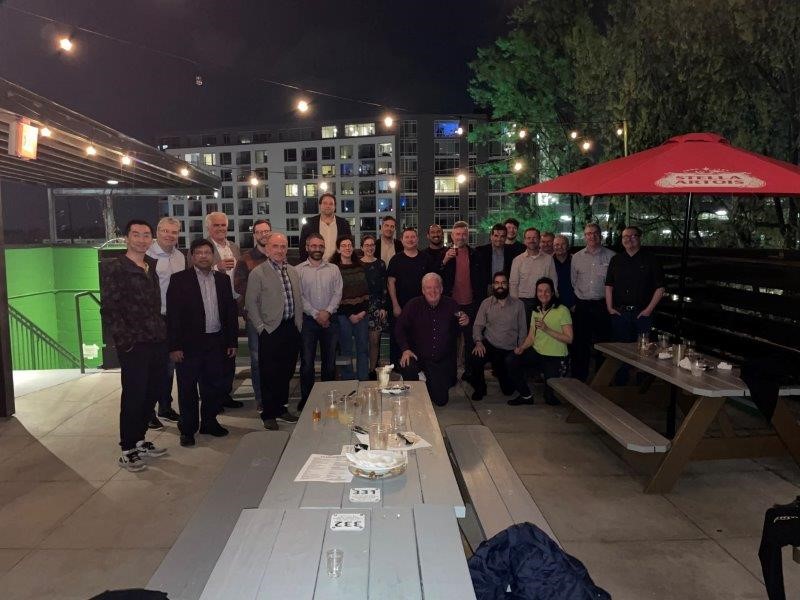
The ASSIST Center (also acting as host) was well-represented by Veena Misra (Director) and EnerHarv General Chair, Mehmet Ozturk, who did a wonderful job with their team (Karen, Candice & Adam) organizing the entire event at their impressive venue in a highly professional and friendly manner. ASSIST provided a keynote, several attendees, presentations and contributed to the panel sessions.
Tech sponsor EnABLES had a strong presence with three posters, four technical presentations and participation in the 'power IoT ecosystem' panel session. EnABLES was cited as a great mechanism to help kick-start initiatives amongst stakeholders and is particularly helpful for SMEs with there being a clear need for such a service. A 'carousel' of 15 of EnABLES TA (Transnational Access) feasibility studies was on display triggering many ideas amongst participants.
Organizer and sponsor PSMA was represented by its Energy Harvesting Committee Co-chairs (& EnerHarv Co-founders) Mike Hayes (Tyndall National Institute) & Brian Zahnstecher (PowerRox) as well as Lisa & Karalyn supporting from the PSMA office. We also leveraged heavily from Technical Co-chair Shad Roundy from University of Utah, both his extensive knowledge and reputation in this area as well as network of contacts.
Finally, some takeaways. These are just a few teasers, and why you need to attend EnerHarv 2024 and beyond to get a deeper insight!
- Whilst there will be a need for billions/trillions of IoT edge devices there is still no 'killer application' and every application has different needs. This reinforces the need for our technologies to be standardized and interoperable so that it will be easy, cost effective and low risk to mix, match and adapt our tech platforms to create custom solutions.
- Life cycle costs are not being fully taken into account. We need to educate the entire ecosystem on this – labor cost, downtime implications, environmental impact, sustainability, etc. and bring in stakeholders that can convey this message.
- Regulations can help change the attitude of the adopter.
- People will always be greedy and use all the power we give them…and more. We need to illustrate the criticality of minimizing power consumption as a means to extend battery life (in harmony with energy harvesting and better batteries/storage devices).
- We need more than just software – we need LOGIC (architecture and intelligence to dynamically collect data in the leanest possible way to meet application need)
- We need to have tools and databases to help better predict battery life and give people assurance of reliable and autonomous operation even in the face of intermittent energy sources.
- Like any good collection of technology and supply chain resources, we all agree we are most in need of end-users. Not just people to buy parts, but industry partners that share an equal passion to address the pain points and bring harvesting (and related) technologies to the mainstream to deliver the perpetually self-powered IoT ecosystem.
Proceedings are already available on the EnerHarv website to attendees and will become publicly available within the next 6-8 months. To get a taste for what you missed, the proceedings of the inaugural EnerHarv 2018 are available on the website (http://www.enerharv.com/). EnerHarv 2024 is likely to return to Europe by which time we hope a future evolution of EnABLES will be in place to continue to build our power IoT community.
We would like to take this opportunity to thank our EnerHarv Workshop Committee (EWC), Organizer and Financial Sponsor PSMA, our Industry Sponsors Analog Devices, UBITO and Wurth Elektronik, Technical Co-sponsors EnABLES, ASSIST, IEEE PELS & CPSS as well as our Media Sponsors Bodo's Power Systems and How2Power.
Many seeds were sown for future collaborations and we look forward to 'harvesting' these at future EnerHarv workshops!
Provided by:
PSMA Energy Harvesting Committee Co-Chairs
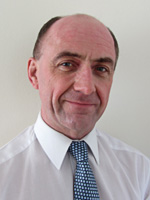
Mike Hayes
Tyndall National Institute
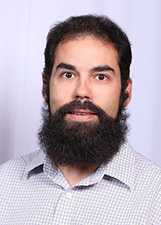
Brian Zahnstecher
PowerRox
 Mendham, NJ— June 15, 2023— The Power Sources Manufacturers Association (PSMA), organizer of the International Workshop on Energy Harvesting and Micro-Power Management, announces that the full catalog of the EnerHarv 2022 conference proceedings is now available to the public. Previously accessible to conference attendees exclusively, the proceedings can now be downloaded, free of charge and without need to register, from the EnerHarv 2022 Data Repository.
Mendham, NJ— June 15, 2023— The Power Sources Manufacturers Association (PSMA), organizer of the International Workshop on Energy Harvesting and Micro-Power Management, announces that the full catalog of the EnerHarv 2022 conference proceedings is now available to the public. Previously accessible to conference attendees exclusively, the proceedings can now be downloaded, free of charge and without need to register, from the EnerHarv 2022 Data Repository. 




 usability. The door is wide open to developers of better passives to migrate and integrate their technologies.
usability. The door is wide open to developers of better passives to migrate and integrate their technologies. bridging the gap between harvester capabilities and load demand. This included some examples of ADI roadmap activities incorporating disruptive technologies particularly in the wearables and Industry 4.0 sectors for sensors, power management and wireless comms. For example, micro-TEG devices at chip scale will be able to give microWatt performance even at very small temperature gradients. Low-leakage, high-cycle supercaps are also in development. Additionally, ADI is looking at sustainability aspects – how to make parts reliable in terms of performance and lifetime.
bridging the gap between harvester capabilities and load demand. This included some examples of ADI roadmap activities incorporating disruptive technologies particularly in the wearables and Industry 4.0 sectors for sensors, power management and wireless comms. For example, micro-TEG devices at chip scale will be able to give microWatt performance even at very small temperature gradients. Low-leakage, high-cycle supercaps are also in development. Additionally, ADI is looking at sustainability aspects – how to make parts reliable in terms of performance and lifetime.
 The Power Management Session comprised speakers from ST Microelectronics, Tyndall and ADI (formerly Maxim). Once again innovative power circuits and architectures were on display to assist with impedance matching (to maximize power transfer), cold start, voltage conditioning and digital interfacing to contextually minimize device power consumption. For example, the MISCHIEF circuit from Tyndall offers a modular circuit block approach offering low-risk, fast-time-to-market development and can harvest ambient energies currently unusable in the sub-10 mW area, particularly at low voltages. Several circuits are in development for WPT applications.
The Power Management Session comprised speakers from ST Microelectronics, Tyndall and ADI (formerly Maxim). Once again innovative power circuits and architectures were on display to assist with impedance matching (to maximize power transfer), cold start, voltage conditioning and digital interfacing to contextually minimize device power consumption. For example, the MISCHIEF circuit from Tyndall offers a modular circuit block approach offering low-risk, fast-time-to-market development and can harvest ambient energies currently unusable in the sub-10 mW area, particularly at low voltages. Several circuits are in development for WPT applications.







